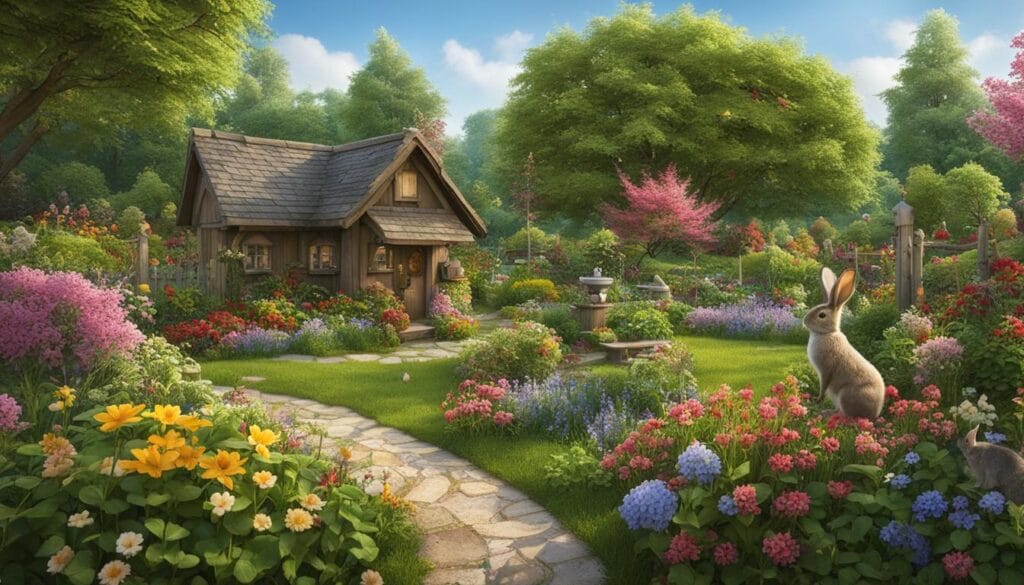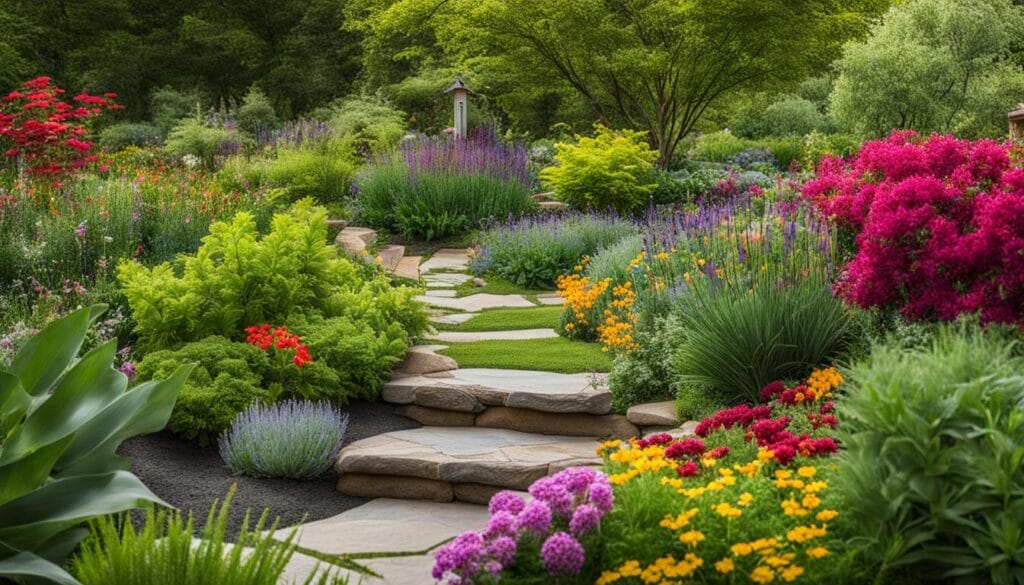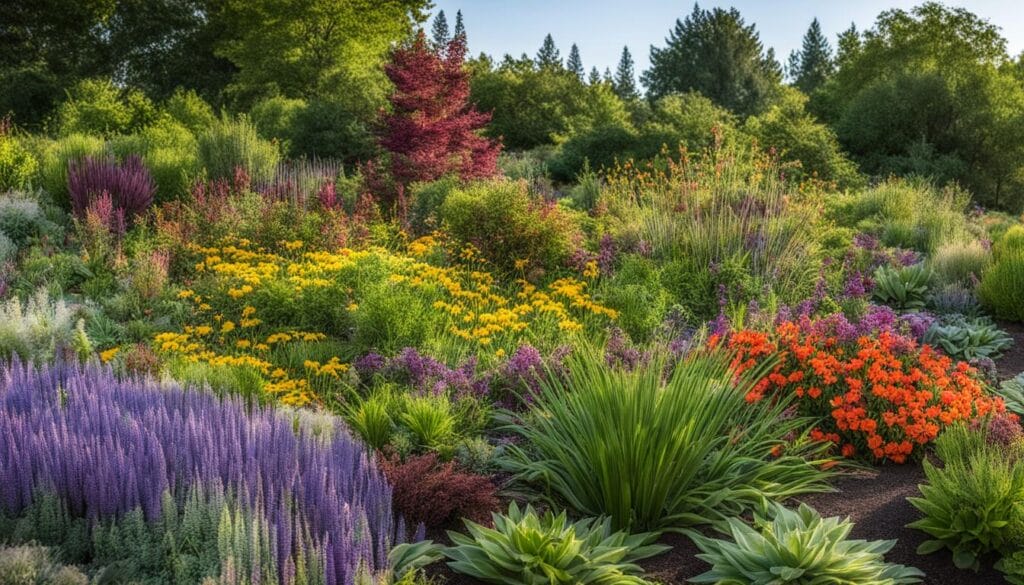Welcome to our comprehensive guide on designing a native plant garden that will attract and support wildlife. Creating a wildlife-friendly garden is not only a way to enhance the beauty of your outdoor space but also an opportunity to contribute to the ecological balance and biodiversity in your area. By incorporating native plants and thoughtful design elements, you can create a thriving habitat that welcomes and sustains a variety of wildlife species.
Attracting wildlife to your garden is a rewarding experience that allows you to observe and interact with nature up close. Whether you are a seasoned gardener or a beginner, this guide will provide you with practical methods rooted in ecological landscape design to help you create a vibrant native plant garden that supports wildlife habitat.
Key Takeaways:
- Designing a native plant garden is a way to create a wildlife-friendly outdoor space that benefits both the environment and your enjoyment.
- By incorporating native plants, you can attract a diverse range of wildlife, including birds, butterflies, bees, and other beneficial insects.
- Consider the natural landscapes around you for inspiration and reflect their elements in your garden design.
- Choose a model landscape based on your site conditions and refine its key elements to fit your area.
- Include a variety of plants with different bloom times to provide food and habitat for wildlife throughout the entire season.
Get Inspired: Considerations for Designing a Native Plant Garden
When designing your native plant garden, look to nature for inspiration. Take a moment to observe and appreciate the natural landscapes around you. Consider what elements of these landscapes you find most appealing and how you can recreate them in your own garden.
Reflecting natural landscape elements in your design can create a harmonious and visually appealing space. Whether it’s the vibrant colors of wildflowers, the gentle slope of a hillside, or the calming sound of a trickling stream, these elements can be incorporated into your garden to create a sense of tranquility and connection with the natural world.
Create attractive plant combinations by selecting native plants that complement each other in terms of color, texture, and bloom time. By carefully choosing a variety of plants, you can create visual interest and ensure that your garden is in bloom throughout the growing season. Mixing different heights and shapes of plants can add depth and dimension to your garden, creating a layered effect that mimics the diversity found in natural ecosystems.
Another important consideration when designing your native plant garden is enhancing wildlife habitat. By incorporating features such as bird feeders, butterfly houses, and nesting boxes, you can provide essential resources for local wildlife. Creating a water source, such as a birdbath or small pond, can attract a wide variety of birds and insects, while rocks and logs can serve as habitats and shelter for small animals.
Remember, designing a native plant garden is not just about aesthetics. It’s about creating a space that enhances and supports the local ecosystem. By taking cues from nature and considering the needs of wildlife, you can create a beautiful and thriving garden that is both visually appealing and beneficial for native flora and fauna.
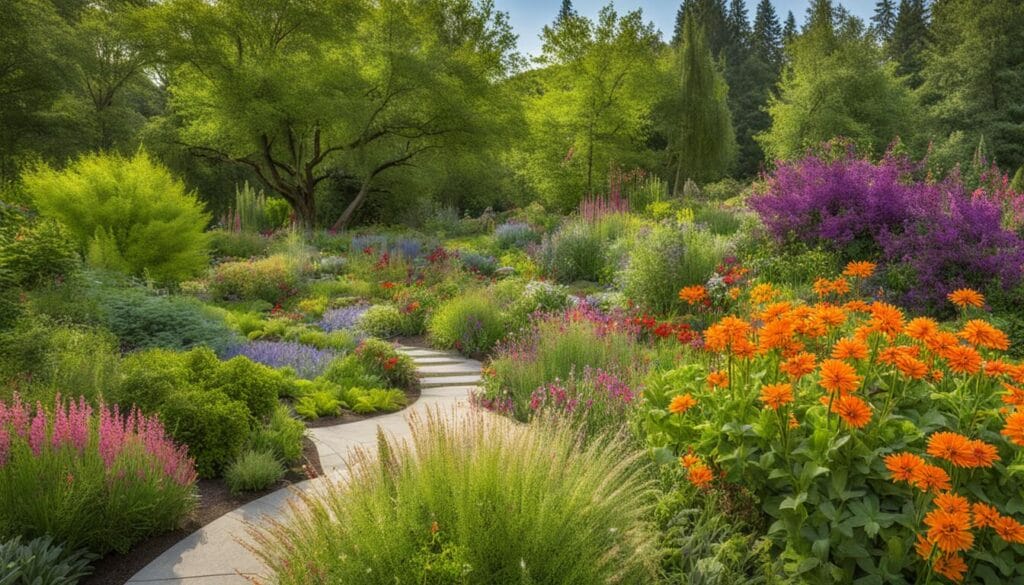
Native Plant Garden Design Tips:
- Observe natural landscapes and reflect their elements in your garden design.
- Create attractive plant combinations by considering color, texture, and bloom time.
- Incorporate features such as bird feeders, nesting boxes, and water sources to enhance wildlife habitat.
- Use rocks and logs to create habitats and shelters for small animals.
Choosing the Right Native Plants for Your Garden
When designing a native plant garden that supports wildlife habitat, selecting the right plants is crucial. By choosing native plants that are well-suited to your garden conditions, you can create an environment that provides food and habitat for local fauna. Consider the following factors when selecting your native plant species:
Local Native Species
Opt for plants that are native to your local area. These plants have evolved alongside native wildlife and are better adapted to the local climate, soil conditions, and pests. They have established ecological relationships with local insects, birds, and other animals, providing essential food and habitat.
Plants for Specific Garden Conditions
Assess your garden’s conditions, such as sunlight exposure, soil type, and moisture levels. Choose native plants that thrive in these conditions to ensure their success in your garden. For example, if you have a sunny and dry area, consider plants that are drought-tolerant and can handle full sun exposure.
Creating Food and Habitat for Wildlife
Look for native plants that provide food and shelter for wildlife. Select species that produce nectar-rich flowers to attract pollinators like bees and butterflies. Include plants that bear fruits, seeds, or nuts, which are valuable food sources for birds and small mammals. Additionally, consider plants with dense foliage or structures like shrubs and trees to provide nesting sites and cover for wildlife.
By carefully selecting native plants that suit your garden’s conditions and provide food and habitat for wildlife, you can create a thriving wildlife-friendly garden ecosystem that benefits both local fauna and flora.
Native Plant Recommendations for Different Garden Conditions
| Garden Condition | Recommended Native Plants |
|---|---|
| Sunny and Dry | Kangaroo Paw (Anigozanthos species) Grevillea species Banksia species Westringia species |
| Shady and Moist | Daintree Pine (Podocarpus sp. ‘Daintree’) Native Violet (Viola hederacea) Scented Sundew (Drosera macrantha) Water Gum (Tristaniopsis laurina) |
| Coastal | Coastal Rosemary (Westringia fruticosa) Pigface (Carpobrotus glaucescens) Coast Banksia (Banksia integrifolia) Lomandra species |
Remember to consider the specific needs of your garden and the local wildlife when choosing native plants for your landscape. These carefully selected plants will not only beautify your garden but also provide a thriving habitat for a variety of wildlife.
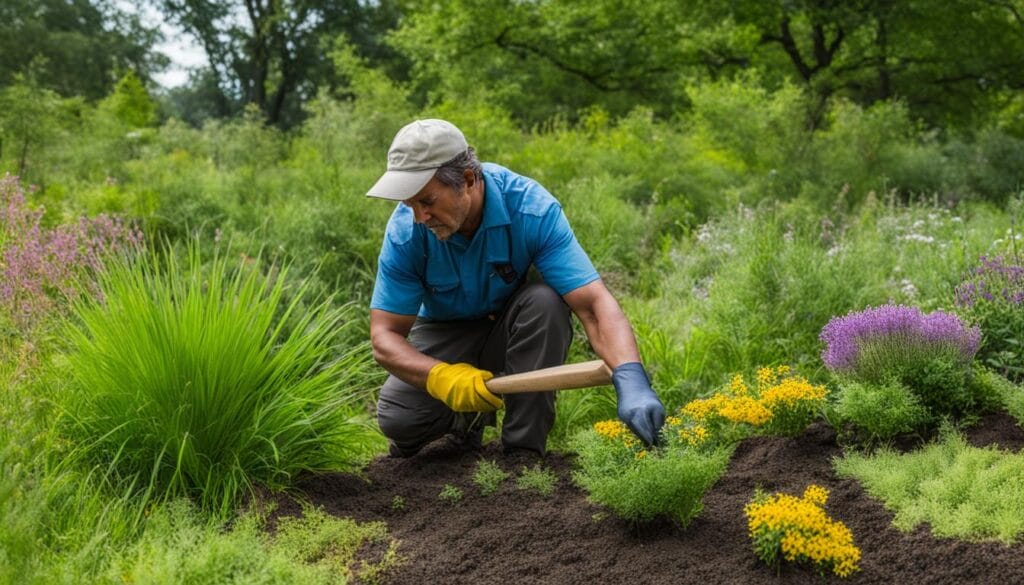
Creating Habitats and Landscaping Features for Wildlife
In addition to choosing the right plants, incorporating wildlife-friendly features into your garden can provide additional habitats for wildlife. By creating a diverse and inviting environment, you can attract a variety of species to your garden and contribute to their well-being.
Landscaping for Wildlife Habitat
When designing your garden, consider incorporating landscaping features that mimic natural habitats for wildlife. These features can provide shelter, food sources, and breeding areas for various species. Some wildlife-friendly elements you can incorporate include:
- Birdbaths and Ponds: Providing water sources such as birdbaths and ponds can attract birds, butterflies, and other pollinators to your garden. Ensure there is a shallow area for animals to land and drink safely.
- Rocks and Logs as Habitat: By adding rocks and logs to your garden, you create hiding spots and shelter for small animals like lizards, frogs, and insects. These natural elements also add visual interest and a sense of authenticity to your landscape.
- Wildflower Meadows: Designating areas of your garden as wildflower meadows can provide nectar-rich flowers for bees, butterflies, and other pollinators. Allow some areas to grow tall grasses and native wildflowers to create a diverse and flourishing habitat.
- Native Trees and Shrubs: Planting native trees and shrubs provides habitat and food sources for birds and other wildlife. Choose species that are well-suited to your local climate and provide year-round benefits, such as berries or nesting sites.
Incorporating these wildlife-friendly elements into your garden not only enhances its beauty but also supports the ecological balance of your local ecosystem. Your garden can become a haven for wildlife, providing them with the resources they need to thrive.
Creating Wildlife-Friendly Elements
In addition to landscaping features, there are other ways you can create a wildlife-friendly environment in your garden:
- Provide Nesting Boxes: Installing nesting boxes can attract birds and bats, providing them with safe spaces to raise their young. Research the specific requirements of different bird species and position the boxes accordingly.
- Use Native Mulch and Compost: Using organic mulch and compost made from local materials not only enriches the soil but also supports the growth of native plants and the wildlife that depends on them.
- Minimize Chemical Use: Avoid using chemical pesticides or herbicides in your garden, as they can harm wildlife. Instead, embrace natural pest control methods and let nature maintain its balance.
- Leave Dead Plant Material: Leaving some dead plant material in your garden, such as flower stalks or fallen leaves, provides habitat for insects and other small creatures.
By incorporating these wildlife-friendly elements into your garden, you can create a vibrant ecosystem that supports a wide range of species. Enjoy the beauty of nature right in your own backyard while contributing to the conservation of local wildlife.
| Wildlife-Friendly Elements | Benefits |
|---|---|
| Birdbaths and Ponds | – Provides water sources for birds and pollinators – Attracts wildlife to your garden |
| Rocks and Logs as Habitat | – Creates shelter for small animals – Adds visual interest to your landscape |
| Wildflower Meadows | – Provides nectar-rich flowers for pollinators – Supports biodiversity in the garden |
| Native Trees and Shrubs | – Offers habitat and food sources for birds – Enhances the ecological balance |
| Provide Nesting Boxes | – Attracts birds and bats for nesting – Supports breeding and population growth |
| Use Native Mulch and Compost | – Enriches the soil with local organic matter – Supports native plant growth |
| Minimize Chemical Use | – Avoids harm to wildlife – Maintains ecological balance |
| Leave Dead Plant Material | – Provides habitat for insects and small creatures – Supports ecological processes |
Conclusion
Creating an Australian native garden is a wonderful way to celebrate the diverse and stunning flora and fauna of our beautiful country. By incorporating native plants and designing with wildlife-friendly features, you can transform your outdoor space into a thriving oasis that supports local ecosystems.
By choosing to create a native plant garden, you are not only embracing the beauty and charm of Australian plants, but also contributing to the resilience and sustainability of our environment. Native plants are adapted to our climate, requiring less water and maintenance, and providing food and habitat for local wildlife.
Designing a garden that attracts and supports native fauna is a rewarding experience. Imagine the sight of colorful birds flitting between the branches, the gentle hum of bees as they pollinate the flowers, and the peaceful presence of butterflies dancing in the breeze. Your garden can be a sanctuary that connects you to the natural world around you.
With proper planning, plant selection, and care, your native garden will continue to bring joy and inspiration for years to come. So, go ahead and create an Australian native plant oasis in your own backyard. Let the beauty of our unique flora and fauna thrive and flourish as you enjoy the resilience and sustainability of your ecologically friendly garden.
FAQ
How do I design a native plant garden that attracts wildlife?
By using ecological design principles and reflecting natural landscapes in your design, you can create a vibrant garden that enhances wildlife habitat. Choose a model landscape based on your site conditions and refine its key elements to fit your area. Design with a range of heights, contrasting plantings with clean lines and edges, and include plants that provide blooms throughout the entire season to attract pollinators.
What should I consider when choosing native plants for my garden?
It’s important to select plants that are adapted to your local climate, soil conditions, and garden size. Consider the ultimate size of the plants, their purpose and function in your garden, and whether they will provide food and habitat for wildlife. Choosing local native species ensures that your garden supports the needs of native flora and fauna.
How can I incorporate wildlife-friendly features into my garden?
You can provide additional habitats for wildlife by adding birdbaths and ponds for water sources, rocks and logs for refuge areas, and natural materials like stone and timber for hardscaping. By including these elements in your garden design, you can create a diverse and inviting habitat for a variety of wildlife species.
Why should I create a native plant garden?
Creating a native plant garden allows you to celebrate the unique flora and fauna of your region. By incorporating native plants and designing with wildlife-friendly features, you can create a resilient and ecologically sustainable garden that supports local ecosystems. It’s a beautiful way to connect with the natural world and create a sanctuary in your own backyard.
Source Links
- https://www.nwf.org/-/media/Documents/PDFs/Garden-for-Wildlife/Ecological-Landscape-fact-sheet.ashx?la=en&hash=3E0016C934D84DD49B70EAA0780ED8377BC80B5C
- https://www.brisbaneplantnursery.com.au/blogs/blog/a-comprehensive-guide-to-creating-an-australian-native-garden
- https://cdn.environment.sa.gov.au/landscape/docs/hf/creating-wildlife-friendly-garden.pdf

